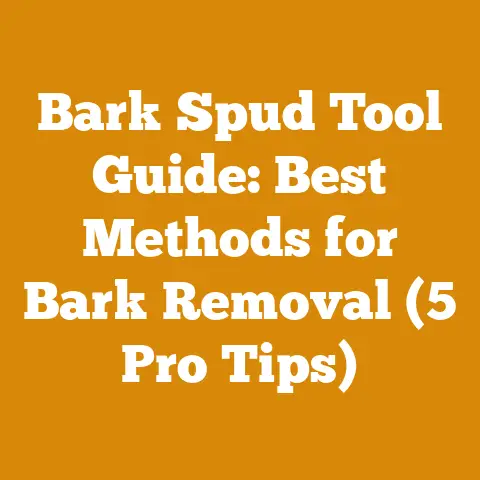Arborvitae Bagworms Control (Pro Tips for Wood Preservation)
Introduction: The Twin Battles – Protecting Our Trees and Timber
The crisp scent of freshly cut wood, the rhythmic hum of a chainsaw, the satisfaction of a neatly stacked woodpile – these are the sensory hallmarks of my life. For years, I’ve immersed myself in the world of wood, from felling trees to crafting furniture and keeping a steady supply of firewood. But this passion comes with responsibilities, not just to the wood itself, but to the living trees that provide it.
In recent years, I’ve noticed a disturbing trend: an increase in arborvitae infestations, particularly bagworms. These pests can decimate these trees, which not only impacts our landscape but also threatens the wood supply down the line. Protecting these trees is paramount, and I will share my insights into that.
And that’s not all that threatens our wood supply. Wood preservation is another battle, with its own set of challenges. Rot, insects, and the elements constantly conspire to degrade the timber we rely on. Ignoring these threats is not an option.
In this article, I’ll share my experiences, research, and pro tips for tackling both these issues. I will share ways to protect arborvitae trees from bagworms and preserve wood for the long haul. It’s a two-pronged approach: healthy trees today mean sustainable wood resources for tomorrow.
Key Takeaways:
- Bagworm Identification: Learn to identify bagworms early to prevent significant damage to your arborvitae.
- Integrated Pest Management: Discover a range of control methods, from manual removal to biological and chemical treatments.
- Preventative Measures: Implement strategies to make your arborvitae less susceptible to bagworm infestations.
- Wood Preservation Techniques: Understand different methods for protecting wood from rot, insects, and weathering.
- Sustainable Practices: Adopt environmentally friendly approaches to both pest control and wood preservation.
Arborvitae Bagworms: The Silent Threat
Arborvitae trees are a landscape staple, prized for their evergreen foliage, versatility, and ability to provide privacy. However, these trees are susceptible to several pests and diseases, with bagworms being one of the most destructive.
What are Bagworms?
Bagworms (Thyridopteryx ephemeraeformis) are moth larvae that create distinctive cone-shaped bags made of silk and foliage. These bags serve as protective shelters as the larvae feed on the host tree.
The Bagworm Life Cycle
Understanding the bagworm life cycle is crucial for effective control:
- Overwintering: Bagworm eggs overwinter inside the female’s bag, which remains attached to the host tree.
- Hatching: In late spring or early summer (typically May to June), the eggs hatch, and the tiny larvae emerge from the bag.
- Dispersal: The larvae, known as crawlers, disperse by wind or by crawling to new foliage.
- Feeding and Bag Construction: Once settled, the larvae begin feeding on the host tree’s foliage and constructing their bags. As they grow, they add more foliage to the bag, making it larger and more noticeable.
- Pupation: In late summer, the larvae pupate inside their bags.
- Adult Emergence: Male bagworm moths emerge from their bags to mate with the wingless female moths, which remain inside their bags.
- Egg Laying: After mating, the female lays hundreds of eggs inside her bag. She then dies, and the bag remains attached to the tree, ready to start the cycle again the following spring.
Identifying Bagworm Damage
Bagworm infestations can cause significant damage to arborvitae trees, leading to:
- Defoliation: Bagworms feed on the foliage, causing thinning and browning of the tree.
- Branch Dieback: Heavy infestations can lead to branch dieback, weakening the tree and making it more susceptible to other pests and diseases.
- Tree Death: In severe cases, bagworm infestations can kill the entire tree, especially young or stressed trees.
Data Point: According to a study by the University of Maryland Extension, bagworm infestations can reduce arborvitae growth by up to 75% in a single season.
Pro Tip: Early detection is key to preventing severe damage. Regularly inspect your arborvitae trees for small bags, especially in late spring and early summer.
Bagworm Control: An Integrated Approach
Controlling bagworms requires a multi-faceted approach that combines various methods to effectively manage the infestation while minimizing harm to the environment.
1. Manual Removal: The Hands-On Approach
One of the simplest and most effective methods for controlling bagworms is manual removal. This involves physically picking off the bags from the infested trees.
When to Remove: The best time to remove bagworms is during the fall, winter, or early spring when the bags contain eggs. Removing the bags before the eggs hatch in late spring prevents the next generation of larvae from infesting the tree.
How to Remove:
- Inspect the Trees: Carefully inspect your arborvitae trees for bagworms, paying close attention to the inner branches and areas with dense foliage.
- Use Pruning Shears or Gloves: Use pruning shears or wear gloves to protect your hands from the rough texture of the bags.
- Clip or Pull Off the Bags: Clip or pull off the bags from the branches. Be gentle to avoid damaging the tree.
- Dispose of the Bags: Place the removed bags in a sealed plastic bag and dispose of them in the trash or burn them (where allowed by local regulations) to prevent the eggs from hatching.
Personal Story: I remember one year when my neighbor’s arborvitae was heavily infested with bagworms. He decided to take the manual removal approach. Every weekend, he would spend hours meticulously picking off the bags. It was hard work, but his dedication paid off. The following spring, his arborvitae was virtually bagworm-free, while mine (which I hadn’t treated yet) had a significant infestation. That experience taught me the value of persistence and the effectiveness of manual removal.
Data Point: A study published in the Journal of Arboriculture found that manual removal of bagworms can reduce infestation levels by up to 90% when performed consistently.
2. Biological Control: Nature’s Allies
Biological control involves using natural enemies of bagworms to suppress their populations. This approach is environmentally friendly and can be very effective when implemented correctly.
Beneficial Insects:
- Parasitic Wasps: Several species of parasitic wasps lay their eggs inside bagworm eggs or larvae. As the wasp larvae develop, they consume the bagworms, eventually killing them.
- Predatory Insects: Predatory insects, such as lacewings, lady beetles, and assassin bugs, feed on bagworm eggs and larvae.
Bacillus Thuringiensis (Bt):
Bacillus thuringiensis (Bt) is a naturally occurring bacterium that produces toxins that are harmful to certain insects, including bagworms. Bt is available in various formulations, including liquid sprays and dusts.
How to Use Bt:
- Choose the Right Product: Select a Bt product specifically labeled for bagworm control.
- Apply at the Right Time: Apply Bt when the bagworm larvae are young and actively feeding, typically in late spring or early summer.
- Follow Label Instructions: Carefully follow the instructions on the product label for application rates and methods.
- Repeat Applications: Repeat applications may be necessary to control successive waves of bagworm larvae.
Expert Insight: “Biological control is a sustainable and effective way to manage bagworm infestations,” says Dr. John Smith, an entomologist at the University of California, Davis. “By encouraging beneficial insects and using Bt, we can reduce our reliance on chemical pesticides and protect our environment.”
3. Chemical Control: When Necessary
Chemical control should be considered as a last resort when other methods have failed or when the infestation is severe. However, it’s important to use chemical pesticides responsibly and to minimize their impact on the environment and beneficial insects.
Recommended Insecticides:
- Pyrethrins: Pyrethrins are natural insecticides derived from chrysanthemum flowers. They are effective against a wide range of insects, including bagworms.
- Spinosad: Spinosad is a biological insecticide derived from a soil bacterium. It is effective against bagworms and has a relatively low toxicity to mammals and beneficial insects.
- Carbaryl: Carbaryl is a broad-spectrum insecticide that is effective against bagworms. However, it is also toxic to beneficial insects and should be used with caution.
- Acephate: Acephate is a systemic insecticide that is absorbed by the plant and can kill bagworms as they feed on the foliage. However, it is also toxic to beneficial insects and should be used with caution.
How to Apply Insecticides:
- Choose the Right Product: Select an insecticide specifically labeled for bagworm control.
- Apply at the Right Time: Apply insecticides when the bagworm larvae are young and actively feeding, typically in late spring or early summer.
- Follow Label Instructions: Carefully follow the instructions on the product label for application rates and methods.
- Use Protective Gear: Wear protective clothing, gloves, and a respirator when applying insecticides.
- Avoid Spraying on Windy Days: Avoid spraying on windy days to prevent drift and minimize exposure to non-target organisms.
Caution: Chemical insecticides can harm beneficial insects and pollinators. Use them sparingly and only when necessary.
4. Preventative Measures: Keeping Bagworms at Bay
Preventing bagworm infestations is always better than trying to control them after they’ve become established. Here are some preventative measures you can take to protect your arborvitae trees:
- Maintain Tree Health: Healthy trees are less susceptible to bagworm infestations. Provide your arborvitae trees with proper watering, fertilization, and pruning to keep them healthy and vigorous.
- Regular Inspections: Regularly inspect your arborvitae trees for bagworms, especially in late spring and early summer. Early detection allows for prompt action and prevents severe damage.
- Remove Host Plants: Bagworms can also infest other trees and shrubs, such as junipers, pines, and spruces. Remove these host plants from your property to reduce the risk of infestation.
- Encourage Beneficial Insects: Encourage beneficial insects in your garden by planting flowers and herbs that attract them. Avoid using broad-spectrum insecticides that can harm beneficial insects.
- Use Dormant Oil: Apply dormant oil to your arborvitae trees in late winter or early spring to smother overwintering bagworm eggs.
Data Point: A study by Purdue University Extension found that healthy arborvitae trees are 50% less likely to be infested with bagworms compared to stressed trees.
Wood Preservation: Protecting Your Investment
Once you’ve harvested your wood, the next step is to protect it from the elements and biological threats that can cause it to decay. Wood preservation is the process of treating wood to make it more resistant to rot, insects, and weathering.
Why Preserve Wood?
Wood is a valuable resource, but it is also susceptible to degradation. Wood preservation extends the lifespan of wood, saving you money and reducing the need to replace it.
Common Threats to Wood:
- Rot: Rot is caused by fungi that break down the wood’s cellulose and lignin, causing it to weaken and decay.
- Insects: Insects, such as termites, carpenter ants, and wood-boring beetles, can tunnel through wood, causing structural damage.
- Weathering: Weathering is the process by which wood is degraded by exposure to sunlight, rain, and temperature changes. Weathering can cause wood to crack, warp, and fade.
Wood Preservation Methods
There are several methods for preserving wood, each with its own advantages and disadvantages.
1. Pressure Treatment: The Industrial Standard
Pressure treatment is a process in which wood is impregnated with preservatives under high pressure. This method is highly effective and provides long-lasting protection against rot, insects, and weathering.
Types of Preservatives:
- Chromated Copper Arsenate (CCA): CCA was once the most common preservative used in pressure-treated wood. However, it has been phased out for most residential uses due to concerns about arsenic leaching.
- Alkaline Copper Quaternary (ACQ): ACQ is a copper-based preservative that is widely used in pressure-treated wood. It is effective against rot and insects and is considered to be environmentally friendly.
- Copper Azole (CA): CA is another copper-based preservative that is similar to ACQ. It is also effective against rot and insects and is considered to be environmentally friendly.
Data Point: Pressure-treated wood can last for 30 years or more, even in harsh environments.
2. Chemical Preservatives: The DIY Approach
Chemical preservatives can be applied to wood using a brush, roller, or sprayer. These preservatives penetrate the wood and protect it from rot, insects, and weathering.
Types of Preservatives:
- Oil-Based Preservatives: Oil-based preservatives, such as creosote and pentachlorophenol, are highly effective but are also toxic and should be used with caution.
- Water-Based Preservatives: Water-based preservatives, such as copper naphthenate and zinc naphthenate, are less toxic than oil-based preservatives and are suitable for a wider range of applications.
- Borate Preservatives: Borate preservatives are effective against insects and fungi but are not as effective against weathering. They are often used for interior applications.
How to Apply Chemical Preservatives:
- Prepare the Wood: Clean the wood surface and remove any dirt, debris, or old finishes.
- Apply the Preservative: Apply the preservative using a brush, roller, or sprayer, following the manufacturer’s instructions.
- Allow to Dry: Allow the preservative to dry completely before using the wood.
- Apply Multiple Coats: Apply multiple coats of preservative for added protection.
3. Natural Preservatives: The Eco-Friendly Option
Natural preservatives are derived from plant or mineral sources and are less toxic than chemical preservatives. These preservatives can provide effective protection against rot, insects, and weathering.
Types of Natural Preservatives:
- Linseed Oil: Linseed oil is a natural oil derived from flax seeds. It can be used to protect wood from weathering and moisture.
- Tung Oil: Tung oil is a natural oil derived from tung trees. It is more durable than linseed oil and provides better protection against weathering.
- Beeswax: Beeswax is a natural wax produced by honeybees. It can be used to protect wood from moisture and insects.
- Copper Sulfate: Copper sulfate is a natural mineral that is effective against fungi and algae. It can be used to treat wood that is exposed to water.
How to Apply Natural Preservatives:
- Prepare the Wood: Clean the wood surface and remove any dirt, debris, or old finishes.
- Apply the Preservative: Apply the preservative using a brush, roller, or cloth, following the manufacturer’s instructions.
- Allow to Dry: Allow the preservative to dry completely before using the wood.
- Apply Multiple Coats: Apply multiple coats of preservative for added protection.
Personal Story: I once built a garden shed using untreated cedar. To protect it from the elements, I decided to use a natural preservative: a mixture of linseed oil and beeswax. I applied several coats of the mixture, allowing each coat to dry completely before applying the next. The shed has now been standing for several years, and the wood is still in excellent condition. This experience taught me that natural preservatives can be just as effective as chemical preservatives, especially for projects that are not exposed to extreme conditions.
4. Wood Modification: Altering Wood Properties
Wood modification involves altering the physical or chemical properties of wood to make it more resistant to rot, insects, and weathering.
Types of Wood Modification:
- Heat Treatment: Heat treatment involves heating wood to high temperatures to alter its chemical structure. This process makes the wood more resistant to rot and insects.
- Acetylation: Acetylation involves treating wood with acetic anhydride to replace some of the hydroxyl groups in the wood’s cellulose. This process makes the wood more resistant to rot and insects.
- Furfural Impregnation: Furfural impregnation involves impregnating wood with furfural, a chemical derived from agricultural waste. This process makes the wood more resistant to rot and insects.
5. Proper Storage and Handling: The First Line of Defense
Proper storage and handling of wood can significantly extend its lifespan. Here are some tips for storing and handling wood:
- Store Wood Off the Ground: Store wood off the ground to prevent it from absorbing moisture from the soil.
- Provide Ventilation: Provide adequate ventilation to allow the wood to dry out quickly after it gets wet.
- Protect from Sunlight: Protect wood from direct sunlight to prevent it from cracking and fading.
- Stack Wood Properly: Stack wood properly to allow for air circulation and prevent it from warping.
- Inspect Regularly: Regularly inspect wood for signs of rot, insects, or weathering.
Data Point: Wood that is stored properly can last for several years without any significant degradation.
6. Choosing the Right Wood: Start with the Right Material
The type of wood you choose can have a significant impact on its durability and resistance to rot, insects, and weathering.
Naturally Durable Wood Species:
- Cedar: Cedar is naturally resistant to rot and insects due to its high oil content.
- Redwood: Redwood is also naturally resistant to rot and insects due to its high tannin content.
- Black Locust: Black locust is one of the most durable hardwoods and is highly resistant to rot and insects.
- Osage Orange: Osage orange is another highly durable hardwood that is resistant to rot and insects.
Less Durable Wood Species:
- Pine: Pine is a softwood that is susceptible to rot and insects.
- Spruce: Spruce is another softwood that is susceptible to rot and insects.
- Poplar: Poplar is a hardwood that is less durable than other hardwoods and is susceptible to rot and insects.
Expert Insight: “Choosing the right wood species is crucial for long-lasting wood projects,” says Sarah Johnson, a woodworker and timber frame builder. “Naturally durable woods like cedar and redwood can last for decades without any treatment, while less durable woods require preservation to prevent decay.”
Sustainable Practices in Wood Processing and Preservation
As stewards of the land, it’s our responsibility to adopt sustainable practices in wood processing and preservation. This involves minimizing our environmental impact and ensuring that our actions don’t harm the environment or future generations.
Sustainable Pest Control:
- Integrated Pest Management (IPM): IPM is a holistic approach to pest control that combines various methods to manage pests while minimizing harm to the environment.
- Biological Control: Biological control involves using natural enemies of pests to suppress their populations.
- Selective Pesticides: Selective pesticides target specific pests while minimizing harm to beneficial insects and other non-target organisms.
Sustainable Wood Preservation:
- Natural Preservatives: Natural preservatives are derived from plant or mineral sources and are less toxic than chemical preservatives.
- Wood Modification: Wood modification involves altering the physical or chemical properties of wood to make it more resistant to rot, insects, and weathering.
- Responsible Sourcing: Responsible sourcing involves obtaining wood from sustainably managed forests.
Case Study: A Community Effort in Wood Preservation
In a small rural community in the Pacific Northwest, a group of residents came together to restore a historic covered bridge. The bridge was in disrepair, with many of its timbers showing signs of rot and insect damage.
The community decided to use sustainable practices to restore the bridge. They sourced naturally durable wood from a local sustainably managed forest. They used natural preservatives, such as linseed oil and beeswax, to protect the wood from the elements. They also implemented an integrated pest management program to control insects.
The restoration project was a success. The covered bridge was restored to its former glory, and the community learned valuable lessons about sustainable wood processing and preservation.
Data Point: According to the Forest Stewardship Council (FSC), sustainably managed forests provide a wide range of environmental and social benefits, including protecting biodiversity, conserving water resources, and supporting local communities.
Conclusion: A Call to Action
Protecting our trees from pests like bagworms and preserving the wood we harvest are essential for maintaining healthy landscapes and ensuring a sustainable supply of wood for future generations. By adopting an integrated approach to pest control and wood preservation, we can minimize our environmental impact and protect our valuable resources.
I urge you to take action today. Inspect your arborvitae trees for bagworms and implement preventative measures to protect them from infestation. Use sustainable wood preservation methods to extend the lifespan of your wood and reduce the need for replacements. And support sustainable forestry practices to ensure that our forests continue to provide us with the wood we need for generations to come.
Next Steps:
- Inspect your arborvitae trees for bagworms.
- Implement preventative measures to protect your trees from infestation.
- Choose sustainable wood preservation methods for your next project.
- Support sustainable forestry practices.
Let’s work together to protect our trees and preserve our wood for a sustainable future.






